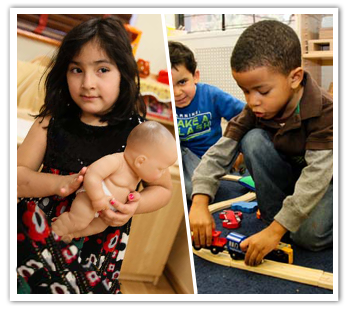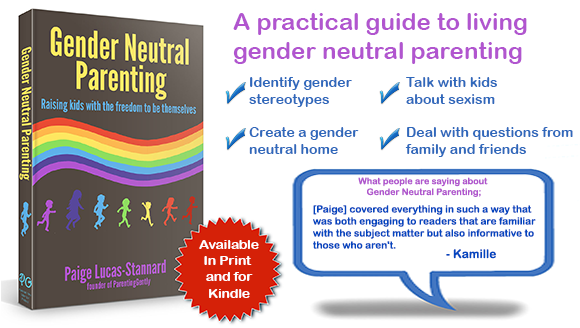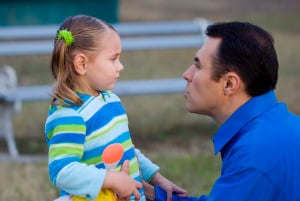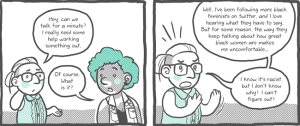
Credit: NAYEC
The day I found out the baby I was carrying was a girl, I bought a frilly, pink dress. It had taken me a long time to get pregnant and I wanted a girl. Yes, I wanted a “healthy baby” but I was honest enough with myself to say I preferred a girl.
In retrospect, it seems incongruent with my feminist views that I did something so “pigeonholing” to my 20 week old fetus. Shouldn’t I have rushed out to buy The Feminine Mystique to read her in-utero?
Everywhere you look, there are pink princesses and blue football shirts. The “gender neutral” section – defined by blank green and yellow onesies – of a store like Babies R Us is almost non-existent.
This is largely because most parents today know the sex of their child prior to birth thanks to ultrasound technology. The demand for clothes that are non-gendered is lower and companies step in with specialized clothing that increases their sales.
Parenting outside the mainstream boy/girl dichotomy can seem daunting to say the least. Am I not allowed to think that dress is cute? Is it ok if I put my baby boy in that jumper with the soccer ball on the butt? What do I do when the photographer calls my daughter “princess” for the millionth time?
The desire to not pigeonhole a child into a specific gender based solely on their biological sex is called Gender Neutral Parenting (GNP) and it isn’t easy to know what Gender Neutral Parenting is and is not.
Recently a psychologist named Dr. Keith Ablow stated on Fox & Friends that a woman was “nuts” for giving her son a doll (you can see the video here). Let’s just set aside for a moment the abelism of calling someone “nuts” because you don’t agree with them.
His view of “gender bending” couldn’t be further from the truth and he falls prey to several common myths about Gender Neutral Parenting.
So let’s set the record straight:
Myth #1: Gender Neutral Parenting Is About Androgyny
This myth posits that gender neutral parenting’s goal is to create a genderless world by abolishing all concepts of male or female. Parents only allow non-gendered toys in neutral colors and androgynous clothing.
Reality: Although the 1970s saw a smattering of articles claiming androgyny as the pinnacle of human evolution – the theory that gender roles are completely learned – we now tend to see gender as a blending of biological (nature) and cultural (nurture) influences. Dr. Ablow said parents “wrench [it] in to some kind of non-genderness.”
However, GNP does not seek to force androgyny on children any more than it wishes to force traditional masculinity or femininity on children.
The whole point of GNP is that is doesn’t force any preconceived gender norms onto a child in the hopes that they can find their own comfort spot on the continuum we call gender.
Myth #2: Gender Neutral Parenting Will Make Your Kid Gay
Many organizations, such as Focus on the Family, specifically conflate gender-bending behavior in children as “signs of pre-homosexuality” and recommend interventions to promote “gender-proper” behaviors.
Reality: Most ongoing research points to a strong genetic component to homosexuality. Therefore, being gay is not something a parent can “train” a child to be. Even children raised by lesbian mothers or gay fathers aren’t more likely to be gay themselves. A child’s sexual orientation will be what it will be. Nothing a parent does will change that.
GNP will not influence their sexual orientation but it can have a profound effect on how traumatizing their upbringing is. A child with the freedom to choose their own comfort level on the gender spectrum and the sexuality spectrum will be less likely to be crushed under parental expectations that conflict with their inner life.
The whole point of GNP is that sex – e.g. the assignment at birth based on external genitalia – should not dictate “allowable” behaviors. If you like pink tutus, you should be able to like them with acceptance regardless of your sex.
According to TransActive, 85% of gender bending children/youth are cisgender and identify as heterosexual in adulthood. So, you heard it here. Johnny (or Beckett) wearing nail polish will not make him gay.
Myth #3: Gender Neutral Parenting Is Anti-Feminine Or Anti-Masculine
Dr. Ablow also said, “What’s so bad about kids being able to be masculine and feminine?” His statement implies that GNP suppresses or shames feminine or masculine behaviors.
Reality: Gender Neutral Parenting isn’t “neutral” at all it is about diversity and removing limitations to gender expression.
If we limited girls from wearing pink or boys from playing football, then we would be replacing one set of artificial limits for another.
What we want to do is expose kids to a wide range of gender-types and give them the freedom to explore without judgment those that call to them.
Paige Schilt uses the term “gendery” to define this concept;
Rather than just begrudgingly allowing our children to play with “opposite gender” toys, the gendery parenting paradigm would encourage us to give children the language to think critically about gender binaries and gendered hierarchies.
With this in mind we would not pass judgment on a child’s choices but help them to think critically about the options society presents.
If your daughter proudly proclaims that “dolls are for girls” while playing, instead of correcting her, open a dialogue.
You might find that a friend at school told her dolls are for girls or that someone had teased her about playing with her dinosaur collection. Opening a dialogue is so much more powerful than a room full of gender neutral toys that raise no questions.
Myth #4: Gender Neutral Parenting Is Only For Trans Kids
This myth supposes that Gender Neutral Parenting is only valuable or should only be employed after a child has displayed gender-bending behaviors. GNP helps trans and gender non-conforming kids overcome the pain of being different but it has no value for a cisgender child.
Reality: First, no one knows when a child is born if he/she/they are trans, non-binary, and/or gender non-conforming. According to Transgender Law and Policy Institute, 2-5% of all people are trans and as mentioned above, most gender-bending kids will not be trans as adults.
It is true that GNP will provide a safer and more nurturing environment that’s absent in most trans childrens’ lives. However, cisgender children can also benefit greatly from GNP in two ways.
One, without strict gender rules children tend to find their place on the spectrum that is not so extreme as hyper-masculine or hyper-feminine but instead represent a spectrum of expression that allows children to find their own strengths and weaknesses.
A child might be amazing at construction and become a prominent architect but only if they have access to building toys and the freedom to explore with them.
Secondly, even stereotypically feminine/masculine children raised in a GNP environment will have the ability to critically question gender assumptions and to appreciate the diversity of gender roles.
Myth #5: Gender Neutral Parenting Is A Social Experiment
When families say they won’t divulge the gender of their child, some get in an uproar about “using” kids for political purposes or brainwashing them as some type of science experiment.
Reality: Everything we say and do with our kids is our attempt to teach them to function in the world at large. I want to raise my children to be good people. To me, this does not mean teaching them to tow the line and conform. It means them being strongly feminist with a passion for equality and social justice.
Traditional gendered parenting is every bit as much indoctrination. Gender norms are taught to mold a kid into an adult that fits into society’s definition of the gender binary. Girls wear pink, like to nurture others, and are emotional. Boys don’t cry, play sports, and make money.
Even if you aren’t intentionally trying to train this into them you are by the default of gender suggestions that ubiquitously surround us everyday. Think Barbie saying “Math is Hard” and then ponder why so few women enter science, technology, engineering, and medicine. Think “boys don’t play with baby dolls” and then ponder why men don’t have the same skill level with newborns that women do.
GNP is trying to break down that narrow definition of what a child can be. If that is a political statement then it is one I’m proud to make.
So What Does This Look Like?
Was buying that pink dress anti-GNP? I don’t think so. As an introspective person, I had an awareness of my gender-laden choice. What if my child who was assigned female at birth doesn’t like dresses? Doesn’t like pink? Doesn’t identify as a girl?
Practicing traditional, gender-biased parenting would be only letting your girls wear pink frilly frocks and making statements that subtly limit the choice. For example, “that’s not girly enough” or “you’d just look adorable in the pink one” all train her to know that mom (and society) expect her to be girly.
It would be just as gender-biased to tease my daughter for wanting to wear pink. For example, rolling my eyes with a “ugh, that is so frilly” could make her feel bad for liking traditionally feminine things.
The main way I strike a balance? I encourage her voice. I try to take my opinions out of the equation.
I’m always looking for an opening to say “which one do you like?” and respecting her choice. I let her tell me what she wants to do with her hair (no forced barrettes and uncomfortable headbands in the name of not being mistaken for a boy).
I engage her in conversations about people’s abilities (e.g. “Why is Alicia your favorite character on Go Diego, Go!”) so she can articulate things beside gender.
I don’t get bent out of shape when photographers call her “princess” but I make sure at home to comment on what a superhero she is when she lifts the garbage bag out of the trash can.
As she gets even older, I can ask “why do you like that one?” and start conversations based on stereotypical answers.
Most parents I know cringe when their seven year old says “that’s for girls.” But really, this is a great opportunity to start a dialog about gender. When the photographer calls her princess, we can later discuss why that is and what it means to be a princess.
And I can let her hear my voice. I’m girly. I own a pink hammer. Not sure if that is nature or nurture but I am self-aware. I’ve let gender-expectations limit me in the past and my growing awareness of it has made me a better person.
Someday, if she asks why pictures of her at 3 months old are an explosion of pink, I’ll tell her that was my way of celebrating her.
Then I’ll tell her that now I celebrate her so much more by watching her learn to celebrate her own unique self.
***
For more information about raising kids with Gender Neutral Parenting, read Paige’s book Gender Neutral Parenting: Raising Kids with the Freedom to Be Themselves.
[do_widget id=”text-101″]
Paige Lucas-Stannard is a parenting educator and writer and the founder of ParentingGently.com, which offers resources to help progressive parents find their authentic voices and implement respectful, values-based (and fun!) parenting in their homes including her new book, Gender Neutral Parenting: Raising kids with the freedom to be themselves. Follow her on Twitter @babydust, on Facebook, and on Pinterest. Read her articles here.
Search our 3000+ articles!
Read our articles about:
Our online racial justice training
Used by hundreds of universities, non-profits, and businesses.
Click to learn more
Most Read Articles
- « Previous
- 1
- …
- 30
- 31
- 32




















